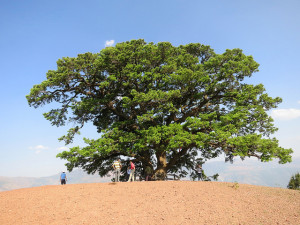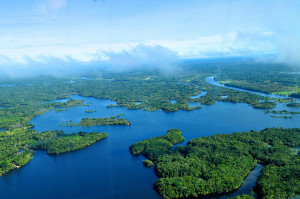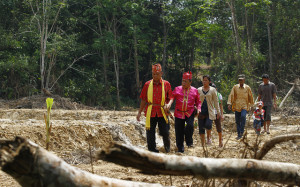
Research on REDD+ and Climate Change forms an important part of the CGIAR Research Program on Forests, Trees and Agroforestry (FTA). One of the scientists involved is CIFOR’s Amy Duchelle who contributed a chapter on REDD+ to a book on the Sustainable Development Goals. On the occasion of Earth Day, Samuel McGlennon presents the book and explains why an integrated approach to the SDGs is necessary to ensure their success and protect planet and people.
Adapted from CIFOR’s Forests News
Earth Day—celebrated every April 22—marks the anniversary of the birth of the modern environmental movement during the 1970s.
Today, the fight to protect our planet’s resources- particularly our forests- continues with increasing urgency amid climate change threats and continuing deforestation. Close to 1.6 billion people – more than 25 percent of the world’s population – rely on forest resources for their livelihoods, according to the United Nations Food and Agriculture Organization (FAO).
The Sustainable Development Goals (SDGs), agreed upon by the United Nations in September 2015, are a universal set of goals, targets and indicators that UN members will use to frame their policies over the next 15 years. They are now a centerpiece of international efforts to chart a more responsible course and provide a road map to benefit both people and the planet.
Each of the 17 SDGs identifies a subject of importance such as poverty, gender equality and climate. Soon, each of the goals will have indicators attached to them, against which progress can be measured.
The recently published book, “Sustainability Indicators in Practice,” explores the opportunities and challenges associated with their practical application.
One of the major conclusions that emerges is the importance of integration of goals, suggesting that the SDGs need not be pursued independently and that on the contrary, they could be more effective when interlinked.
This approach proposes integrating subjects of importance that were previously held distinct. This means that ‘conserving more forest area’, for example, cannot be achieved independently of other goals like ensuring viable livelihoods for local populations.
“A shift towards more integrated monitoring of sustainability indicators really holds a lot of promise,” said Amy Duchelle, a contributor to the book and a scientist at the Center for International Forestry Research (CIFOR).

Duchelle’s research focused on examining a more integrated monitoring of the carbon and non-carbon outcomes of Reducing Emissions from Deforestation and Forest Degradation (REDD+).
Duchelle’s chapter on REDD+, co-authored with Martin Herold and Claudio di Sassi, aims to provide ‘a real-life example’ of where and how integrated monitoring could work.
While REDD+ has always had a strong focus on carbon sequestration; but comprehending its other outcomes – such as its impact on livelihoods and biodiversity – may be just as important for ensuring the program’s long-term viability.
The United Nations Framework Convention on Climate Change REDD+ Safeguards institutionalizes a shortlist of these other outcomes that extend beyond carbon, including social and environmental impacts.
Duchelle says that more integrated monitoring, while ambitious, is also highly desirable.
“For one, it would allow us to better understand trade‑offs and synergies between the various potential outcomes of REDD+. There is also the potential for integrated monitoring to be more cost-effective than monitoring outcomes separately.”
Sizable challenges remain

And while some types of integration are simply desirable, other types have become a necessity.
For Duchelle, institutions and programs who put REDD+ Safeguards into place take a promising step in the right direction, because they explicitly recognize the need to integrate the various outcomes of REDD+.
But sizeable challenges remain, and one is bringing together the people and organizations who still work in disciplinary silos. Another obstacle is measuring the social impacts of REDD+, particularly those related to local rights and participation, for which data may be limited in national and sub-national surveys.
Integration needed throughout SDGs
Agnieszka Latawiec, the book’s editor and Research Director at the International Institute of Sustainability in Rio de Janeiro, Brazil, emphasizes how integration actually has a broad relevance to many sets of indicators.
“We now see a multiplicity of approaches towards sustainability, as evidenced by the sheer range of indicators – measures of sustainability – across a whole variety of topics. And that diversity is not necessarily a bad thing.
“But, one thing this book shows is that different aspects of each system are tightly interlinked, which means that striving to improve one indicator may affect others.”
Latawiec concludes that there are clear lessons stemming from this understanding.
“What we find across all of the sustainability indicators in the book is the importance of getting the simple things right.
“That means, initially, selecting a set of indicators that are strongly grounded and easy to understand, and using them appropriately.
“But their inter-relatedness also suggests that, as much as possible, we work towards improving sustainability indicators collectively, as a set.” This is exactly the conclusion the authors of the REDD+ chapter have drawn.











